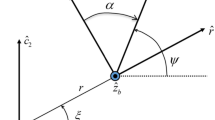Abstract
In recent years, several countries have shown an increasing interest toward both manned and automatic lunar missions. The development of a safe and reliable guidance algorithm for lunar landing and soft touchdown represents a very relevant issue for establishing a real connection between the Earth and the Moon surface. This paper applies a new, general-purpose neighboring optimal guidance algorithm, proposed in a companion paper and capable of driving a dynamical system along a specified nominal, optimal path, to lunar descent and soft landing. This new closed-loop guidance, termed variable-time-domain neighboring optimal guidance, avoids the usual numerical difficulties related to the occurrence of singularities for the gain matrices, and is exempt from the main drawbacks of similar algorithms proposed in the past. For lunar descent, the nominal trajectory is represented by the minimum-time path departing from the periselenium of a given elliptic orbit and arriving at the Moon with no residual velocity. Perturbations arising from the imperfect knowledge of the propulsive parameters and from errors in the initial conditions are considered. At specified, equally spaced times the state displacements from the nominal flight conditions are evaluated, and the guidance algorithm yields the necessary control corrections. Extensive robustness and Monte Carlo tests are performed, and definitely prove the effectiveness, robustness, and accuracy of the new guidance scheme at hand, also in comparison with the well-established linear tangent steering law.










Similar content being viewed by others
References
Klumpp A.R.: Apollo Guidance, Navigation and Control: Apollo Lunar Descent Guidance. Massachusetts Institute of Technology, Charles Stark Draper Lab., TR-R695, Cambridge, MA (1971).
Chomel, C.T., Bishop, R.H.: Analytical lunar descent guidance algorithm. J. Guid. Control Dyn. 32(3), 915–926 (2009)
Lee A.Y.: Fuel-efficient Descent and Landing Guidance Logic for a Safe Lunar Touchdown. AIAA Guidance, Navigation and Control Conference, Portland, OR (2011). AIAA Paper 2011–6499.
Hull, D.G.: Optimal guidance for quasi-planar lunar descent with throttling. Adv. Astron. Sci. 140, 983–994 (2011). Paper AAS 11-169
Acikmese, B., Ploen, S.R.: Convex programming approach to powered descent guidance for mars landing. J. Guid. Control. Dyn. 30(5), 1353–1366 (2007)
Pontani M., Cecchetti G., Teofilatto P.: Variable-time-domain neighboring optimal guidance, Part 1: Algorithm structure. J. Optim. Theory. Appl. doi:10.1007/s10957-014-0676-6
Vinh, N.X.: Optimal Space Trajectories in Atmospheric Flight, pp. 47–59. Elsevier, Amsterdam (1981)
Hull, D.G.: Optimal Control Theory for Applications. Springer, New York (2003)
Eberhart, R., Kennedy, J.: A new optimizer using particle swarm theory. In: Proceedings of the Sixth International Symposium on Micromachine and Human Science, Nagoya, Japan (1995)
Pontani, M., Conway, B.A.: Particle swarm optimization applied to space trajectories. J. Guid. Control. Dyn. 33(5), 1429–1441 (2010)
Pontani, M., Conway, B.A.: Optimal low-thrust orbital maneuvers via indirect swarming method. J. Optim. Theory Appl. (2013)
Pontani, M., Conway, B.A.: Optimal finite-thrust rendezvous trajectories found via particle swarm algorithm. J. Spacecr. Rock. 50(6), 1222–1234 (2013)
Pontani, M., Conway, B.A.: Particle swarm optimization applied to impulsive orbital transfers. Acta Astron. 74, 141–155 (2012)
Townsend, G.E., Abbott, A.S., Palmer, R.R.: Guidance, Flight Mechanics and Trajectory Optimization, vol. VIII. Boost Guidance Equations. NASA Contractor Report, Washington, D.C. (1968)
Smith I.E.: General Formulation of the Iterative Guidance Mode. Technical Memorandum X-53414, NASA Marshall Space Flight Center, Huntsville, AL (1966)
Fishman, G.S.: Monte Carlo Concepts, Algorithms, and Applications. Springer, New York (1996)
Ash, R.B.: Basic Probability Theory. Dover, Mineola (2008)
Author information
Authors and Affiliations
Corresponding author
Additional information
Communicated by David G. Hull.
Rights and permissions
About this article
Cite this article
Pontani, M., Cecchetti, G. & Teofilatto, P. Variable-Time-Domain Neighboring Optimal Guidance, Part 2: Application to Lunar Descent and Soft Landing. J Optim Theory Appl 166, 93–114 (2015). https://doi.org/10.1007/s10957-014-0675-7
Received:
Accepted:
Published:
Issue Date:
DOI: https://doi.org/10.1007/s10957-014-0675-7
Keywords
- Lunar descent and landing
- 2nd order sufficient conditions for optimality
- Perturbative guidance
- Neighboring optimal guidance




